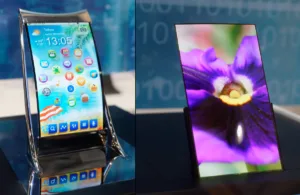Visiting JDI at SID is always a challenge – there is always so much to see and so much of it is both innovative and genuinely interesting to specialist display geeks like us. We have two extra articles about what JDI showed, but we also went around the booth. (JDI Shows Floating 3D and Light Field Displays)
The first display we looked at a reflective 32″ FullHD LCD using a front light and using JDI’s Memory-in-Pixel (MIP) to use just 260mW in still image reflective mode. The display uses around 40 times more power in its video mode, but that still means a very low power display. JDI is interested in applications where, for example, the display might be solar/battery powered such as in transport applications. Matt reported on the paper at the Symposium and took an image with flash in the display’s reflective mode, which looked better than the front-lit mode that I captured. (JDI Shows Reflective Display For Digital Signage)
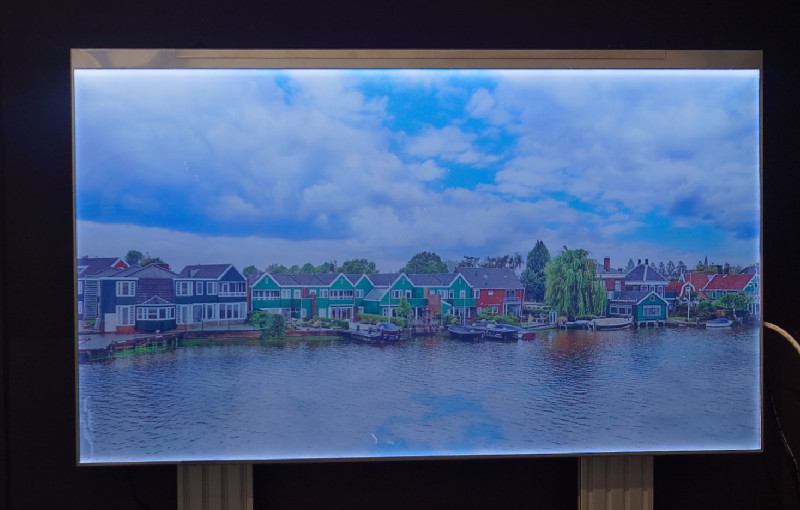 JDI’s reflective 32 inch has front-lit (here) and reflective modes. Image:Meko
JDI’s reflective 32 inch has front-lit (here) and reflective modes. Image:Meko
As well as digital signage, the MIP LCD technology is useful in wearables and there was a round 1.04″ reflective display with 8 colours that uses very low power. It has 208 x 208 resolution and there are also larger versions with 64 colours with 1.1″ diagonal (218 x 218) and 1.2″ (240 x 240)
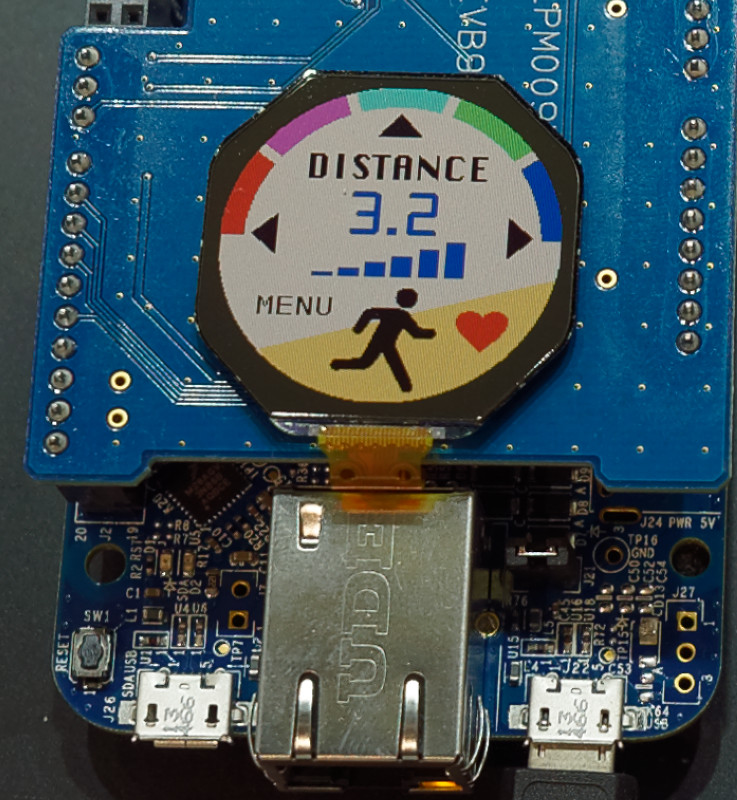 JDI’s 1.04″ MIP wearable display uses very little power. Image:Meko
JDI’s 1.04″ MIP wearable display uses very little power. Image:Meko
JDI is working with E Ink to improve the performance of EPD displays. In the past, E Ink displays used amorphous silicon (a-si) backplanes. However, JDI has developed LTPS backplanes that can improve the resolution of the E Ink displays from 112ppi using a-si to 400ppi or even 600 ppi. The E Ink display layer stays the same, but by using a finer grained substrate and field, there is, effectively, sub-pixel level control of the ink particles. JDI was showing samples of 400 ppi and 600 ppi and highlighted that it also allowed narrower borders and integrated sensors. Although the company described the project as ‘just a technology test’, as we heard in the Business Conference, LTPS LCD will come under a lot of competitive pressure from AMOLED, so LTPS backplanes may become available for this application, although they will cost more than a-si.
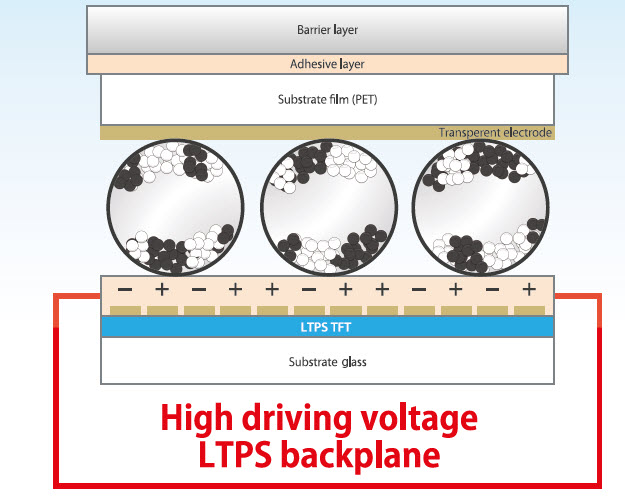 JDI worked with E Ink to make LTPS backplanes, with sub-pixel addressing. Image:JDI
JDI worked with E Ink to make LTPS backplanes, with sub-pixel addressing. Image:JDI
JDI now has a third generation of development of its LTPS technology and has been working on lower refresh rates to reduce power consumption, but without generating flicker. The company was showing a panel running at 15Hz when static images are being shown, which reduces drive power by around 50% from the Gen 1 in 2015 and by 30% from last year’s Gen 2. The system detects when there is motion and can switch to 60Hz. The 5.5″ display has just 0.55mm borders and 2560 x 1440 resolution (538 ppi)
Next we looked at some 3.4″ LCDs with 1440 x 1700 resolution (651 ppi) for VR headsets. The panels have 3ms response (B/W), 6ms (G2G) and can support 90Hz refresh. The company uses a blinking backlight to help with motion and claims a 1ms BET (blur edge time). Contrast is 800:1 and the
JDI is responding to requests for narrow borders all around the display with its ‘Full Active’ architecture. As well as showing how the technology could allow multi-display devices (see image), it also showed how software could be used to ‘virtually’ combine multiple individual displays on different phones to create a single ‘video wall’ for big images.
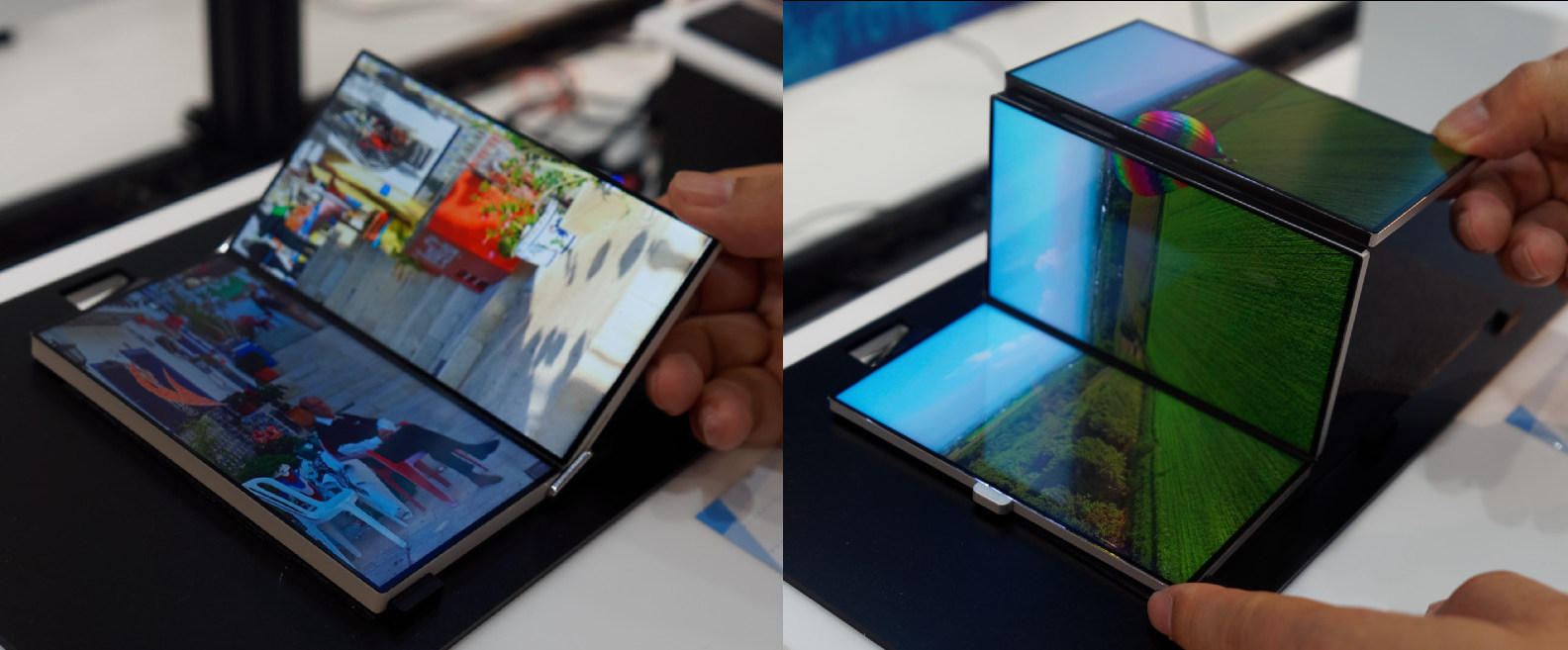 JDI used its narrow border LCDs to show multi-display configurations. Image:Meko
JDI used its narrow border LCDs to show multi-display configurations. Image:Meko
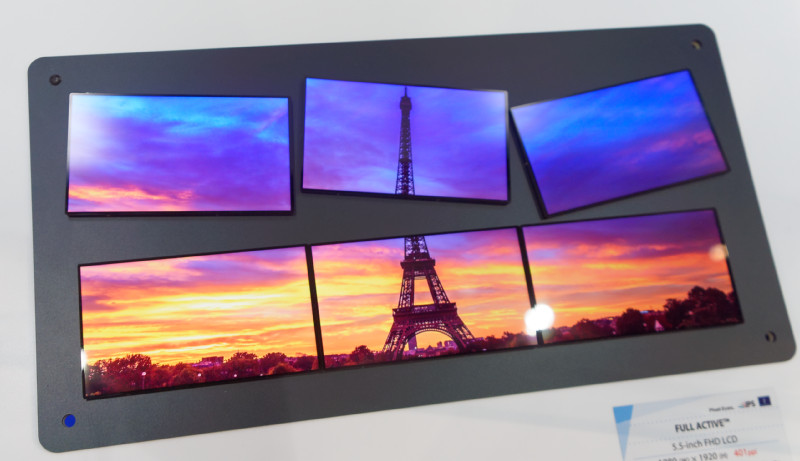 JDI used its Full Active LCDs to create a virtual video wall. Image:Meko
JDI used its Full Active LCDs to create a virtual video wall. Image:Meko
The Full Active displays will be available during 2017, with flexible LCDs (Full Active Flex) coming at the end of the year. By the end of 2018, JDI plans to supply Full Active X foldable displays, including OLEDs.
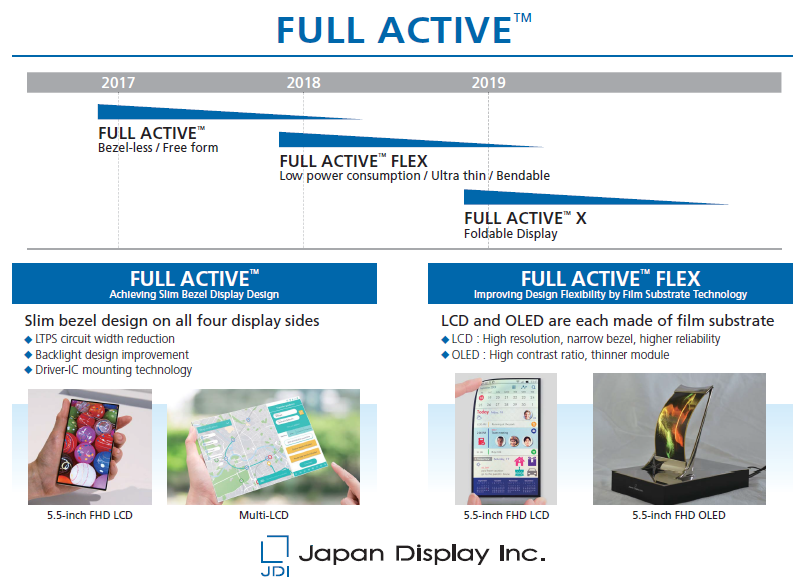
JDI is not yet supplying OLEDs in volume, but had a good looking flexible OLED at the event. The 5.5″ FullHD display had 401ppi and used RGB deposition by fine shadow mask. Although JDI has taken ownership of JOLED and can access its technology, JOLED has been working on inkjet deposition. The display has 700 cd/m² of output and 110% of DCI P3 colour gamut. The substrate is LTPS and was made on the G4.5 pilot line at Ishikawa.
JDI’s flexible displays looked good. The one on the right is an OLED. Image:Meko
A particularly interesting development was a new transparent display. This uses a new LCD mode and has no polariser or colour filter which means that the transparency can be very high – JDI said that the device can get to 80%. The 4″ sample has 300 x 360 resolution (117ppi). The LC material uses scattering. We couldn’t get a lot of detail at the show, but we understand that it uses a frame sequential LED system to eliminate the filter (Sharp showed a transparent FS LCD at ISE earlier this year Impact of Foxconn Acquisiton Shows at Sharp). The light goes through the glass using TIR and the LC material, when subject to a field, frustrates the TIR and the light is emitted. At the moment this is a technology demonstration, but JDI plans to continue development for use in display applications and also for windows and mirrors.
 JDI’s Transparent Display has 80% transmission. Image:Meko
JDI’s Transparent Display has 80% transmission. Image:Meko
Finally, we looked at an instrument cluster mock-up for automotive applications and using dual 10.0″ displays, each with 1440 x 1080 resolution (308 ppi). Contrast is 1500:1 and colour gamut is 75% of NTSC. The LTPS LCDs, which use JDI’s IPS-Neo technology which supports local dimming for true blacks, and which we saw last year, looked good.
 JDI’s Auto Displays have backlight dimming for high contrast and deep blacks. Image:Meko
JDI’s Auto Displays have backlight dimming for high contrast and deep blacks. Image:Meko
That wasn’t the end of the booth, which also covered KOE’s industrial displays and demonstrations of fast response video which was the same demo as last year.

